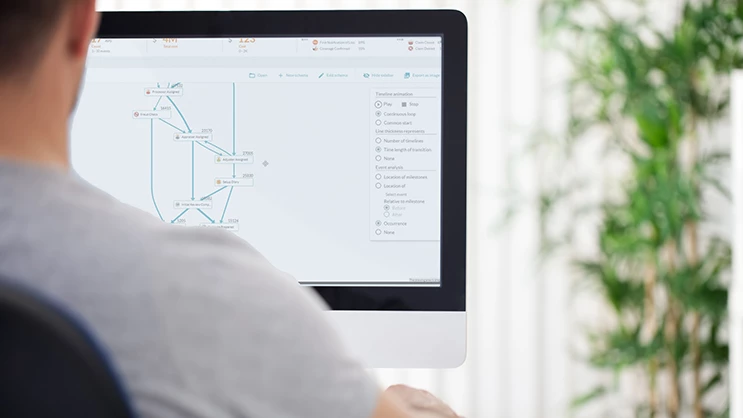Gartner® Innovation Insight: Unlock Finance Transformation With Process Mining

Integrate reliable Document AI in your automation workflows with just a few lines of code
Increase straight-through document processing with data-driven insights
Supercharge AI automation with the power of reliable, accurate OCR
PROCESS UNDERSTANDING
PROCESS OPTIMIZATION
Purpose-built AI for limitless automation.
Kick-start your automation with pre-trained AI extraction models.
Meet our contributors, explore assets, and more.
BY INDUSTRY
BY BUSINESS PROCESS
BY TECHNOLOGY
Build
Integrate advanced text recognition capabilities into your applications and workflows via API.
AI-ready document data for context grounded GenAI output with RAG.
Explore purpose-built AI for Intelligent Automation.
Grow
Connect with peers and experienced OCR, IDP, and AI professionals.
A distinguished title awarded to developers who demonstrate exceptional expertise in ABBYY AI.
Explore
Insights
Implementation
ABBYY Timeline


Process simulation makes it possible to realize the outcomes that optimization will bring before disrupting the actual operation. In other words, before implementing changes for process optimization, it allows users to test those changes to ensure they yield the intended results.




Process simulation provides a mechanism for utilizing process histories to automatically configure a simulation. This model can then be adjusted to reflect any proposed changes to the process or resource allocation, with the goal of understanding the impact of those changes before they are implemented.
Introducing a new or modified business process without first confirming its performance under a variety of simulated conditions can be extremely expensive and risky. Simulation of a planned business process can help your business avoid wasting human resources by evading the rework necessary to correct poor performance not anticipated by process designers.
A flawed process can mean decreased productivity, lost customers, or process compliance violations. In the case of processes whose purpose is to serve a human customer in healthcare, public safety, or other high-risk situations, these failures can be even more dire. Simulations allow organizations to identify and rectify potential failures to mitigate these risks.
Simulation can fast-track changes by instantly showcasing potential outcomes, thus cutting down lengthy trial-and-error cycles and allowing implementation teams to focus all their energy on process implementation, free from the need to rework less-optimal process designs.


Timeline enables you to simulate potential changes to a process and see the impact, so you can make process optimization decisions with confidence.


“ABBYY Process Intelligence has helped us make a real cultural change: to rely on data and make data-driven improvements.”
- Simon Higgs, Director of Business Transformation

Hospitals and healthcare facilities looking to optimize the patient journey through an emergency department can use process simulation to assess various scenarios for improvement before making any changes, like altering a triage system or allocating more staff during peak times. This ensures that the proposed solutions don’t inadvertently increase patient waiting times or overburden staff.

A bank wants to speed up its loan approval process. After mapping the current process through discovery, they simulate various changes—like automating credit checks, introducing digital document verification, or adjusting planned staffing levels. The simulation helps ensure that while the process gets faster, it doesn't introduce any unintended risks by inadvertently impacting the quality of required risk assessments.

A car manufacturer wants to enhance its assembly line efficiency. Using a process digital twin, they simulate changes like reordering assembly stations or introducing robotic arms. Through simulations, they can predict how these changes would affect production times, product quality, and worker safety.

An online retailer wants to optimize its product return process to enhance customer satisfaction. Simulating changes like introducing instant refunds, simplifying return labels, or providing pick-up services allows them to gauge impacts on customer loyalty, operational costs, and inventory management.

The most comprehensive solution for process mining, task mining, process analysis, prediction, simulation, and more.

Use the process simulation tool to analyze processes of interest and test your assumptions regarding their performance.

Watch a demo of the Timeline simulation tool using an insurance claims processing use case.


ABBYY Timeline SAP Connector provides an SAP-certified module that removes the time-consuming steps of data extraction, event log creation, and visualization from SAP applications with just a few clicks.


The ABBYY Timeline Connector for Alteryx brings the power of process intelligence to your Alteryx analytic processes—seamlessly integrating ABBYY Timeline’s process mining and discovery, process analytics and visualization, real-time process monitoring, and predictive process analytics capabilities.


ABBYY Timeline for FlexiCapture is an intuitive, value-added solution that enables you to build a “digital twin” of your FlexiCapture processes, analyze them in real time to identify bottlenecks, and predict future outcomes.

Just as prototyping a new airplane based solely on theory can be extremely expensive and risky, so too can introducing a new or modified business process without first confirming its performance under a variety of simulated conditions…

Today’s customers expect a frictionless experience. Financial Services is now using process intelligence to get the answers they need in order to provide it. Download this ebook to understand how.
ABBYY Timeline is a cloud-based process intelligence platform featuring advanced process discovery, analysis, monitoring, simulation, and task mining.
Just as prototyping a new airplane based solely on theory can be extremely expensive and risky, so too can introducing a new or modified business process without first confirming its performance under a variety of simulated conditions…

Today’s customers expect a frictionless experience. Financial Services is now using process intelligence to get the answers they need in order to provide it. Download this ebook to understand how.
ABBYY Timeline is a cloud-based process intelligence platform featuring advanced process discovery, analysis, monitoring, simulation, and task mining.
Before effecting changes for process optimization, businesses can test those changes to make sure that they will deliver the intended results. Process simulation enables organizations to realize the outcomes that optimization will bring before disrupting the actual operation.
Process simulation provides a mechanism for utilizing process histories to automatically configure a simulation. This model can then be adjusted to reflect any proposed changes to the process or resource allocation, with the goal of understanding the impact of those changes before they are implemented. This helps leaders make informed decisions regarding resource allocation and process changes, ultimately leading to optimized operational efficiency and customer satisfaction.
Introducing a new or modified business process without first confirming its performance under a variety of simulated conditions can be risky. Simulation of a planned business process can help the business avoid wasting human resources by evading the rework necessary to correct poor performance not anticipated by process designers.
In the case of processes whose purpose is to serve a human customer in healthcare, public safety, or other high-risk situations, failures in process prototypes can be dire. Simulations allow organizations to identify and rectify potential failures to mitigate these risks.
Simulation can fast-track process changes by instantly showcasing potential outcomes, thus cutting down lengthy trial-and-error cycles and allowing implementation teams to focus all their energy on process implementation, free from the need to rework less-optimal process designs.
Process simulation can be used in many different industries and many different processes. For example:
Healthcare: Consider a hospital looking to optimize patient flow through its emergency department. Through business process discovery, they've mapped out the current patient journey. However, before making changes—like altering a triage system or allocating more staff during peak times—they can simulate various scenarios to identify unintended issues caused by those changes. This ensures that the proposed solutions don't inadvertently increase patient waiting times or overburden staff.
Manufacturing: A car manufacturer wants to enhance its assembly line efficiency. Using a process digital twin, they simulate changes like reordering assembly stations or introducing robotic arms. Through simulations, they can predict how these changes would affect production times, product quality, and worker safety.
Banking: A bank wants to speed up its loan approval process. After mapping the current process through discovery, they simulate various changes—like automating credit checks, introducing digital document verification, or adjusting planned staffing levels. The simulation helps ensure that while the process gets faster, it doesn't introduce any unintended risks by inadvertently impacting the quality of required risk assessments.
E-commerce: An online retailer wants to optimize its product return process to enhance customer satisfaction. Simulating changes like introducing instant refunds, simplifying return labels, or providing pick-up services allows them to gauge impacts on customer loyalty, operational costs, and inventory management.
The evolution from static design blueprints to dynamic digital twins in engineering was a game-changer. In the realm of business processes, we stand at a similar crossroads. Process discovery is the blueprint, but without simulation, it's like a jet engine design that's never been tested under actual flight conditions.
Process digital twins offer businesses an unparalleled view into their operations, but simulations unlock their transformative potential. By "test driving" changes in a virtual environment, businesses can innovate faster, reduce risks, and ensure cost effectiveness. Independent of the industry, the power of simulation for realizing the full potential of digital twins is reshaping the way industries approach process optimization.
Schedule a demo and see how ABBYY Process Intelligence can change the way you work—forever